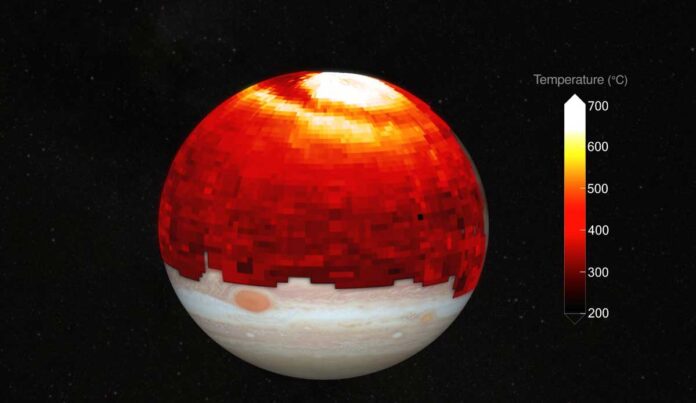An unexpected “heat wave” of 700 degrees Celsius has been discovered in Jupiter’s atmosphere, stretching 130,000 kilometres (10 Earth diameters). The results were presented this week at the Europlanet Science Congress (EPSC) 2022 in Granada by James O’Donoghue of the Japanese Aerospace Exploration Agency (JAXA).
Jupiter’s atmosphere, famous for its multicoloured vortices, is also shockingly hot: hundreds of degrees hotter than models predict. Because of its orbital distance from the sun, the giant planet receives only 4% of the sunlight that Earth receives, and its upper atmosphere should be a chilly -70 degrees Celsius. Instead, its cloud tops are over 400 degrees Celsius everywhere.
“Last year, we created — and presented at EPSC2021 — the first maps of Jupiter’s upper atmosphere capable of identifying the dominant heat sources,” Dr. O’Donoghue explained. “We demonstrated that Jupiter’s auroras were a possible mechanism that could explain these temperatures using these maps.”
Jupiter, like Earth, experiences auroras around its poles as a result of the solar wind. However, whereas auroras on Earth are transient and only occur when solar activity is high, auroras on Jupiter are permanent and vary in intensity. The powerful auroras can heat the region around the poles to over 700 degrees Celsius, and the heat can be redistributed globally around Jupiter by global winds.
Dr. O’Donoghue and his colleagues discovered the spectacular “heat wave” just below the northern aurora, and discovered that it was travelling towards the equator at thousands of kilometres per hour.
The heat wave was most likely caused by a pulse of enhanced solar wind plasma colliding with Jupiter’s magnetic field, which increased auroral heating and forced hot gases to expand and spill out towards the equator. “While the auroras continuously deliver heat to the rest of the planet,” Dr. O’Donoghue added, “these heat wave ‘events’ represent an additional, significant energy source.” “These findings add to our understanding of Jupiter’s upper-atmospheric weather and climate, and are a big help in trying to solve the ‘energy crisis’ problem that plagues giant planet research.”

